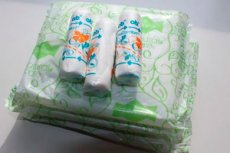New publications
Manufacturers of feminine hygiene products have improved their products
Last reviewed: 02.07.2025

All iLive content is medically reviewed or fact checked to ensure as much factual accuracy as possible.
We have strict sourcing guidelines and only link to reputable media sites, academic research institutions and, whenever possible, medically peer reviewed studies. Note that the numbers in parentheses ([1], [2], etc.) are clickable links to these studies.
If you feel that any of our content is inaccurate, out-of-date, or otherwise questionable, please select it and press Ctrl + Enter.

Feminine hygiene products such as pads, wipes and tampons will now be able to perform a diagnostic function – in particular, to determine the presence of a yeast urogenital infection. When candidiasis appears, special threads in such products will change color – from white to bright pink.
Known pathogens of urogenital candidiasis, or thrush - fungi of the genus Candida - cause an unpleasant sensation of itching, burning, pain in the external genitalia, as well as the appearance of pathological vaginal discharge. According to specialists from the Mayo Clinic Center, at least ¾ of women have suffered from thrush at least once in their lives. This fungal infection is extremely common and can be diagnosed using a vaginal smear. However, many women are deprived of the opportunity to undergo a timely examination for various reasons.
Representatives of the peer-reviewed scientific publication ACS Omega – a journal of the American Chemical Society – have come up with the idea of adding specially treated fibers to feminine hygiene products that acquire a bright pink color when they are joined by fungal flora. As the chemists explain, such a development will help many women to diagnose candidal infections at any time and without any problems.
The researchers took as a basis ordinary sanitary pads and tampons made of multifilament cotton material. To increase the moisture resistance of the fibers, the specialists treated them with a heptane solution, which displaces the binding components that got into the threads during the production process. Then the fibers were impregnated with L-proline-beta-naphthylamide, a substance that reacts with the enzyme of a fungal infection, after which they were built into the internal filler of hygiene products. After adding imitation vaginal secretion with a candida inclusion to these products, a change in the color of the filler from white to bright pink was observed. The diagnostics took only a few minutes.
Another important advantage of the new feminine hygiene products is their relatively low cost: such diagnostic pads or tampons will cost about 25 cents apiece. In the future, scientists plan to adapt them for the comprehensive detection of other pathogenic microorganisms - in particular, bacteria that can provoke the development of urogenital infections.
Urogenital candidiasis is extremely common, regularly regulated worldwide and tends to recur frequently, reducing quality of life and causing physical, sexual and emotional discomfort to women. Therefore, the issue of early diagnosis of this pathology is very relevant.
The invention was presented by employees of the American Chemical Society on their own website
